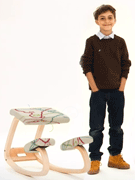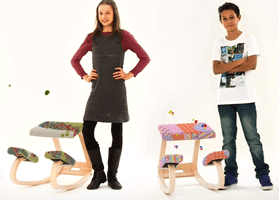Commentary
These Are Your Brain Waves... As Furniture Patterns
- by Amy Corr , Staff Writer @MediaPostOTL, March 5, 2012
Ever watch a furniture ad that touted a chair’s mental or physical health benefits for its users?
Ever wonder what brain waves look like -- and whether the impending design would make for a decent furniture pattern?
Look no further than Varier Furniture’s Variable Balans chair.
Its design, backless with two padded cushions where a person’s knees and lower legs rest, is touted to increase circulation throughout a user’s body. This, in turn, increases the amount of oxygen delivered to the brain, enabling users to concentrate on work longer.
 DIST Creative tapped production company B-Reel to
conduct an experiment in which children’s brain waves were monitored while working on projects seated in a Balans chair.
DIST Creative tapped production company B-Reel to
conduct an experiment in which children’s brain waves were monitored while working on projects seated in a Balans chair.
Three children participated in the experiment. Each wore an Emotiv EPOC Neuroheadset that measured brain waves and levels of concentration. Each child had a favorite field of interest (literature, biology and art) and studied something from their favorite subject.
Engagement, excitement and frustration levels were measured. Data was fed to a custom built visualizer engine that created patterns reflecting real-time changes in the children's brain waves.
“The setup is a little different for each child's design, but essentially they can control size, speed, colour and background with their levels of distraction, frustration, calmness and excitement,” said Lars Bjurman, Creative Director at B-Reel. “We set up rules for the controls so that when the levels coincide according to maximum concentration, the most expressive graphics are produced.”
 The end result was three varying but appealing designs.
The end result was three varying but appealing designs.
Varier Furniture is featuring the project at international furniture and design fairs and advertising in interior decoration magazines -- and plans on having demonstrations available at Varier Showrooms Worldwide for consumers to test-drive.
The chair costs $450 and comes in standard colors like black, red, blue or green, or the patterns made by the three children: Maxwell, Lorenzo and Katjuscha.
“It was enormously fun, and the potential in this kind if mind control is unlimited,” said Bjurman. “We definitely would like to try to make something more deliberately controlled like a game or a live world installation. Imagine controlling a robot on the other side of the world only by using your thoughts, or a live compiled film that you are creating by using your mind.”



